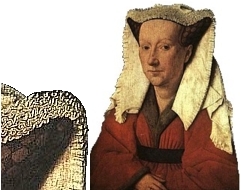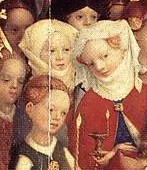Medieval Veil Pins
MEDIEVAL WOMAN SITEMAP • THE BOOK • THE BLOG • ARTIFACT COLLECTION • TUTORIALS•TALKS• NOTICEBOARD
How To Make A Wimple

Now ladies, if you do wish to go to a medieval event with a proper costume you should include a veil: it is not only period, it is practical a practical head covering. I’ve had my hat fly off in the wind more than once, but it has never happened to my veil. First things first, you’ll need your own veil.


Medieval Veil Styles
- Medieval Hats - Veils We have a large variety of renaissance and medieval hats to choose from. Add the finishing touch to your renaissance wardrobe with the perfect hat. We have leather cavalier hats, muffin hats, silk veils, floppy hats, and much more.
- Pins are well documented in medieval archeology. The ideal shape of the top of the veil should be as if it were just lying on your head like a tablecloth - with apparently natural folds and ripples from around the temples downward.
Medieval Face Veil
COIFS | Medieval Veils, Wimples and Gorgets Veils A law passed between 1162 and 1202, in the municipal statues of Arles, which forbade prostitutes to cover their hair with a veil lest they should be mistaken for a woman of good virtue and encouraged good women to snatch the veils from the heads of women of suspected ill-repute. Many Middle Eastern countries of the world today require that a woman's hair remain covered in public. Discussions with many liberated women in these Muslim countries show that they actively choose to continue to wear a veil as a show of modesty and decency and not as a symbol of oppression by the men of their society. It was only the Western society which discontinued the wearing of the veil and wimple. In this respect, wearing a veil was seen as a sign of good breeding and is no different to the generation of our grandmothers who were firmly hatted, stockinged and gloved whenever they left the house. Veil shapes and sizes At some times during the Middle Ages, veils worn by the wealthier and more fashionable were pinned in many overlapping layers, as shown in the detail at left in the 1435 painting of A Man and a Woman by Robert Campin. It is unclear why such a fashion developed. At certain periods of the Middle Ages a veil with two bands of blue around the border was required by law to be worn by Jewish women as an identifying marker of their faith. Coloured veils were not entirely unknown, but it is certain that they were not the most popular. Decorative features on veils A great deal of the artwork and statues in Prague during the middle ages were shown to have quite a large degree of decorative features- notably ruffles, beaded or pearl edging and in some cases, gold embroidery around the edges. Complaints came from many of the clergy, including this from a 13th century preacher in Germany, Berthold of Regensburg:
A French song of the 13th century tells of a traveling merchant who sold kerchiefs with flowers and birds embroidered on them, although most contemporary illustrations of that time period show plain white of varying degrees of fineness and fabric. The Goffered Veil or Nebule Smadav 2018 free download - Music Label 2018, Ashampoo Office 2018, XX Movie Maker 2018 - X Video Maker 2018, and many more programs. SmadAV Pro 2018 Free Download For PC is just one of the very best antivirus programs for separated from the internet use. You can use it paying little respect to the way that you starting currently to have an anti-virus or internet protection suite introduced on your Windows PC. Smadav 2018 12.0 New Version Free Download – The Smadav 2018 12.0 New Version exe antivirus for windows 7 32 64 bit, windows 10 32 64 bit. The explanation about smadav 2018 12.0 review, spesification, features and performance write at the next paragraph. All download links on. Smadav 2018 APK For PC Download Antivirus is an Indonesian antivirus that reputation has started to move all through in condition of its daintiness and plentifulness. SmadAV Antivirus is a plot out as you minute covering security all single PC, yet it’ll begin as your PC’s first affirmation. Smadav 2018 Free Antivirus V11.8 Exe Download Updated A new version of the free Smadav antivirus has been released. This version is known as v11.8, and it comes with some fantastic features. It also protects internet users from the online virus when they have the antivirus installed on their computer. Smadav 2018 for pc. Many illuminations, manuscripts, brasses and effigies show this style of headdress. The detail shown here at left is a statue dated at around 1370 to 1430 of the Madonna and Child showing a veil which is ruffled on the top and at the ends. Many English churches also show this type of veiling. Lady Despencer wears the goffered veil in her effigy at Tewkesbury Abbey, as does a brass of Margaret Torrington in Great Berkhampstead Church, Hertfordshire. Pleated or frilled veils The detail, at right, shows a close up of the pleated ruffles which appear to have been pleated separately and then sewn on to the main veil. This kind of pleating could be either a single layer or many layers. Wimples & Gorgets The wimple or gorget was widely worn by all medieval women of good breeding and it was only later in time that it was dropped for daily wear by the general populace and retained by nuns and holy women. It was not uncommon, although, for a married woman to wear one if she so chose. Effigies and paintings from the 13th century right through to the 15th century show women wearing wimples. The difference between a wimple and a gorget Wimple shapes and sizes This detail at right is taken from a brass memorial of Elizabeth de Northwood from 1335. She is modestly wearing a gorget, as is expected of a married woman, but still shows a deal of her carefully arranged hairstyle. It is important to note that although we can see some of her hair, it is dressed and not out or flowing in any way. Wimple fabrics and colours |

